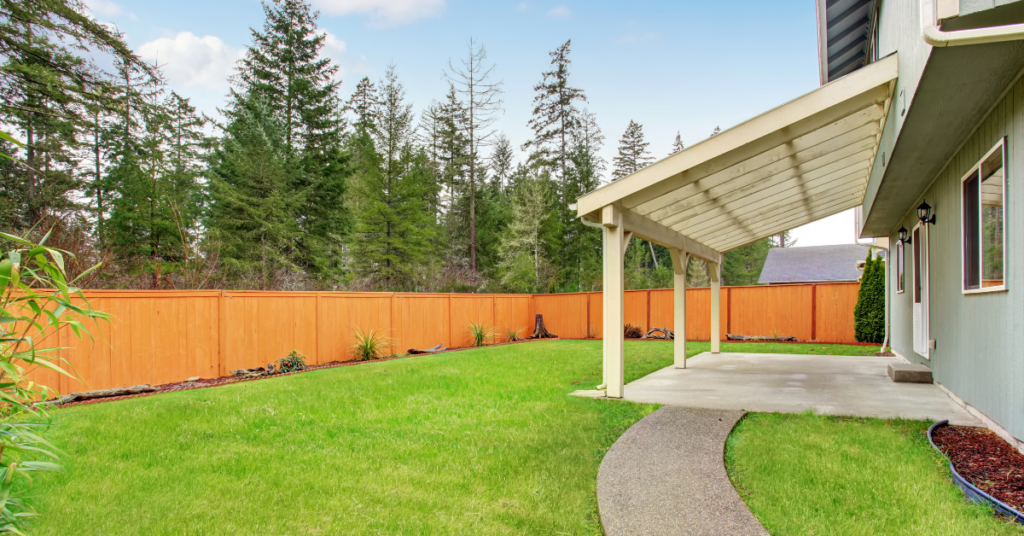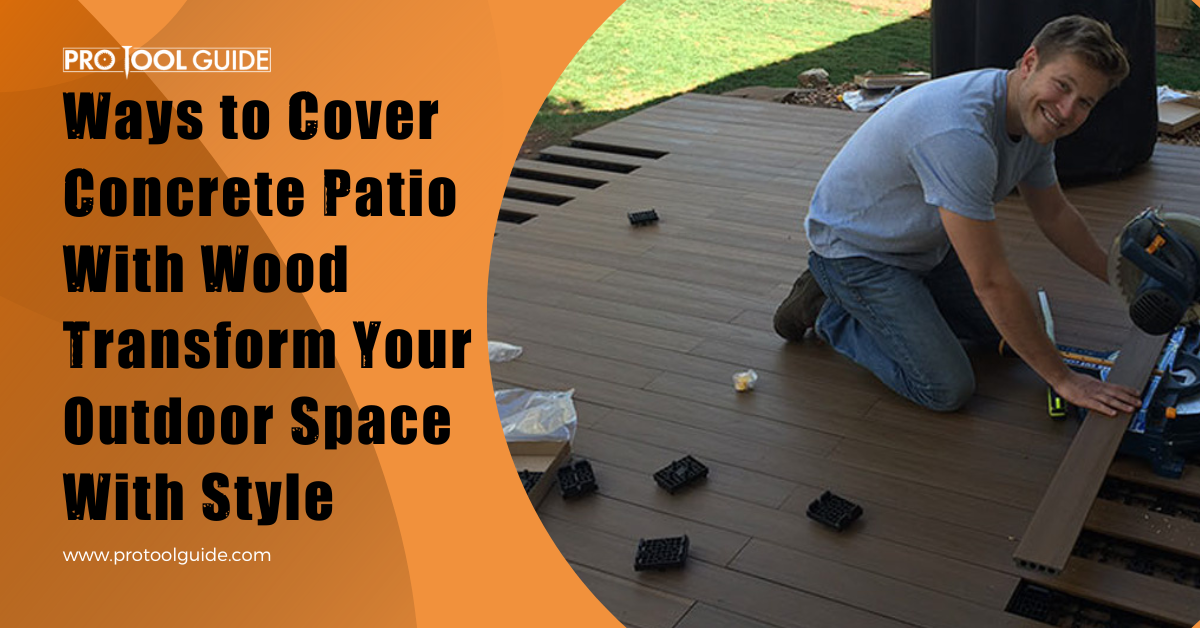Concrete flooring is durable and stable but can be faulted for its lack of flexibility. Sometimes, the old patio flooring requires a face-lift considering the external stress it has faced. Covering the concrete with wood is one of the best ways to give it a warmer and cozier feel.
Decking a concrete patio can quickly transform an otherwise unappealing surface into a trendier surface that improves the patio’s overall appearance. Concrete is often the default flooring for most patios due to its minimal maintenance requirements and superb strength. However, its appeal, tenderness, and flexibility are severely limited, so a wooden covering is an excellent option.
One of the advantages of using wood to cover concrete is the flexibility and variations available that ensures uniqueness. We’ll show you different ways to deck a concrete patio to renew the old surface. So if you’re interested in covering that old concrete patio, follow this guide for variations you can utilize. However, before you jump to the cover methods, you should first digest some considerations.
Factors to Consider Before Covering Concrete Patio

While this can be an exciting project with the capacity to transform the entire patio look, you must navigate these considerations beforehand. It’ll help decide if the wood is the best cover for the concrete floor.
1. Concrete Structure

Even though covering with wood often recovers an old surface, you must ensure the flooring is still structurally sound. Covering a weakened floor with wood can cause accidents. Determining the concrete’s structural integrity and crucial is to fixing it where possible.
Sealing hairline cracks is vital, especially in frigid regions where water can enter the gap and freeze, further affecting its integrity. While inspecting the concrete, ensure it slopes away from the house so water is channeled correctly.
2. Climatic Conditions
Concrete is highly durable and can withstand various climatic conditions, but the same cannot be said for wood. If you must cover it with wood, it is essential to consider your specific climate. Some wooden materials and styles are better suited to certain weather conditions.
If you live in a cold and humid area, you should consider lumber with excellent water-resistant capacities. While hot locations with a lot of sunlight do well with wood that can withstand UV rays without losing its appeal.
3. Patio Style

The style of your patio can affect the type of deck covering you utilize. Some decking fits certain patio styles better, so special consideration should be given before installing the hardwood. There are four popular patio styles, all dependent on the area’s primary use. They include dining, restaurant, sundeck, and living room patios.
Decide the primary use of your patio and match it with a suitable type of decking that will ensure durability and appeal. Nevertheless, none of the ways are set in stone and can be varied based on preference. So feel free to be adventurous in your choices.
Different Ways to Cover Concrete with Wood

Covering concrete with wood opens up many possibilities, as timber is among the versatile flooring materials. This section will consider different ways to deck a concrete patio and achieve a brilliant look.
1. Using Wooden Tiles

Hardwood deck tiles offer essential ventilation when covering concrete since concrete expels moisture. Without proper ventilation, the underside of the deck will soak in water and rot. Deck tiles are also easy to install and can be completed in a weekend or two, depending on the size of your patio.
Aside from their natural resistance to decay, hardwood deck tiles are also durable with an incredible appeal. Because of their impressive durability, the best hardwood deck tiles are made from Brazilian Redwood, Tigerwood, Teak, Garapa, and Ipe. Wood tiles are easy to use since minimal cutting is required, as there are different tile sizes from which to choose.
To complete this project, you’ll require supplies like deck tile connectors, end seal and oil, table saw, chalk line, rubber mallet, tape measure, and hardwood deck tiles. The wood deck tiles typically come in 20′ x 20, 24′ x 24′, and 24′ x 48′ sizes, so measuring and planning the layout will ensure you choose the correct size.
Wooden deck tiles can be expensive, but their ease and style make them a valid option to cover your deck. Follow this link for a detailed installation plan.
2. Using Treated Battens

Your patio is typically exposed to harsh weather conditions and pest attacks, so using pressure-treated wood is essential. This idea featured treated battens that are reinforced to improve durability with battens that encourage flexibility. The battens make it easy to cover different floor shapes and various obstacles.
Measuring the patio floor size is the first step to achieving a suitable cover. Unlike the previous idea, this method involves much cutting to fit the battens into the space. However, this shouldn’t discourage you, as it gets easier with the right tools. Some tools you should get for this project include measuring tape, a table saw, a concrete screw, tapcon-style anchors, a drill, and more.
After cutting the battens to size, pre-drilling each piece will prevent cracking when installing it into the concrete. Also, consider making pilot holes in the concrete to guide the bits during the final installation. Tapcon-style anchors and concrete screws are the preferred materials to secure these battens to the concrete.
Correctly spacing the battens will improve the appeal and durability of your treated batten concrete patio cover. This plan spaces the batten 16 inches from center to center.
3. Using Risers And Boards

Risers raise the wood above the concrete giving you room to work and preventing direct contact with the concrete, which can cause the wood cover to rot. This idea uses pressure-treated 2x4s rated for contact with the ground. The sleepers are 16 inches apart, so the number you’ll require depends on your patio size.
This design suits concrete flooring that has sunk and is not level. You can adjust the riser height for each area to get a level board surface. You’ll need a table saw to cut your boards and sleepers to seize. At the same time, supplies like ramset, adhesive, concrete screws, and regular screws are also essential.
One factor that makes this concrete covering idea inquiry is the level of detail provided. It covers all the angles and problems you may encounter, including recessed areas. The plan features a 5-part series with a detailed process for installing the sleepers, critter-proofing, and installing the boards. It is vital to critter-proof the cover to prevent small animals from making the space between the concrete and boards of their home.
Finishing the board will further strengthen the surface and improve its durability. However, it would help if you aren’t so focused on its durability that you forget to choose an appealing finishing hue that perfectly contrasts the rest of the patio.
4. Deck on Uneven Concrete Surface

Concrete flooring may be uneven since parts sink as it ages or due to poor repairs. Nevertheless, fixing wood above uneven surfaces can be challenging. But with this method, you can achieve a level deck with impressive finishing over your concrete patio.
The idea uses the advanced lumber system to install the deck and adjustable clips to level the concrete pads. Since the project uses a hardwood tile, installing the deck is easy and can be completed quickly. On the other hand, building the frame and setting the adjustable clips will require more effort.
On a flat surface, this tile can be completed in minutes. However, this guide focuses on installing the cover on an uneven surface, requiring more patience. The altitude pedestal is the tool to get a level surface for installing the board. It sports an angle adjustment system to change the slope depending on your concrete surface.
This idea will cost a lot of money as the wooden tiles and the altitude pedestal will increase your budget. Nevertheless, it offers a seamless method to cover uneven concrete surfaces. Check the link for a detailed video guide. It contains a series of explicit videos covering the project.
5. Using Wood Composite Decking

Wood composite decking is made from composite lumber. It is essential to understand that composite lumber is a manufactured material consisting of wood fiber, plastic, and a binding agent similar to plywood. This combination of natural and synthetic ingredients forms a specialized material to make decks over your concrete patio.
Before proceeding with this project, you must get all the required supplies to ensure a seamless deck-building process. Some materials include screws, a drill, a circular saw, a hot glue gun, hot glue, composite wood, and other materials. You may already have all the tools in your garage, which will reduce the cost of purchasing or renting the needed tools.
The guide features a detailed video following the builder through decking over a concrete surface using wood composite. It also includes a written description of the steps to understand the procedure quickly.
Instead of using wood to build the perimeter, this idea covers the sides using PVC trim boards. Ensure you get your dimensions right before cutting to avoid wasting materials. Hot melt, adhesive, and screws help secure the pieces to the concrete and support beams. Finish by concealing the anchors using plug cuts for a clean look.
Summary
Covering unappealing concrete patio surfaces with wood will ensure you get more comfortable flooring. Thankfully, several ways to achieve your goal depend on your needs. We’ve highlighted the process involving even and uneven surfaces and different wooden materials, including tiles and composite.

